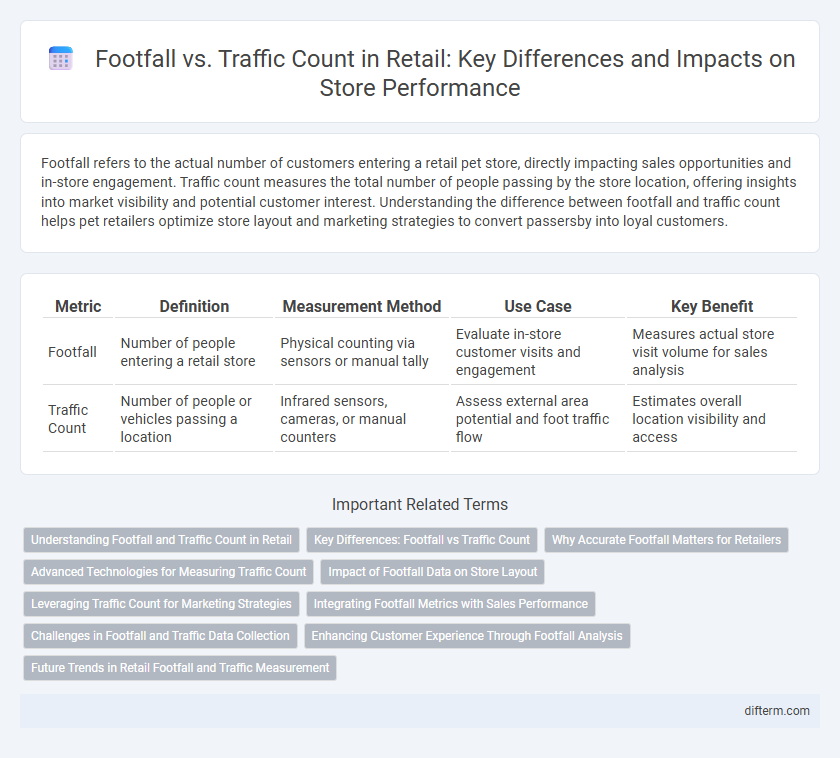Footfall refers to the actual number of customers entering a retail pet store, directly impacting sales opportunities and in-store engagement. Traffic count measures the total number of people passing by the store location, offering insights into market visibility and potential customer interest. Understanding the difference between footfall and traffic count helps pet retailers optimize store layout and marketing strategies to convert passersby into loyal customers.
Table of Comparison
| Metric | Definition | Measurement Method | Use Case | Key Benefit |
|---|---|---|---|---|
| Footfall | Number of people entering a retail store | Physical counting via sensors or manual tally | Evaluate in-store customer visits and engagement | Measures actual store visit volume for sales analysis |
| Traffic Count | Number of people or vehicles passing a location | Infrared sensors, cameras, or manual counters | Assess external area potential and foot traffic flow | Estimates overall location visibility and access |
Understanding Footfall and Traffic Count in Retail
Footfall in retail measures the number of people entering a store, providing insights into customer engagement and store popularity. Traffic count tracks pedestrian or vehicle volume near retail locations, helping to assess potential customer exposure and site accessibility. Analyzing both footfall and traffic count enables retailers to optimize store layout, marketing strategies, and staffing based on actual consumer behavior and location dynamics.
Key Differences: Footfall vs Traffic Count
Footfall refers to the actual number of people entering a retail store or shopping area, while traffic count measures the total number of people passing by the location without necessarily entering. Footfall data provides insights into customer engagement and potential sales opportunities, whereas traffic count helps assess overall visibility and external attraction of the retail site. Understanding these key differences enables retailers to optimize store layouts, marketing strategies, and site selection for better operational efficiency.
Why Accurate Footfall Matters for Retailers
Accurate footfall measurement enables retailers to optimize store layouts, staffing levels, and marketing strategies based on real customer behavior patterns. Reliable footfall data directly influences inventory management, helping prevent stockouts or overstocking by aligning supply with demand fluctuations. Understanding precise traffic counts allows retailers to evaluate promotional effectiveness and improve overall customer experience, driving sustained sales growth.
Advanced Technologies for Measuring Traffic Count
Advanced technologies for measuring traffic count in retail environments utilize AI-powered sensors, video analytics, and IoT devices to deliver precise footfall data. These innovations enable real-time tracking of customer movements, optimizing store layouts and enhancing marketing strategies. High-accuracy traffic data supports informed decision-making, driving improved operational efficiency and increased sales.
Impact of Footfall Data on Store Layout
Footfall data provides critical insights into customer movement patterns within retail spaces, enabling optimized store layout design to enhance shopper experience and increase sales. By analyzing footfall metrics such as peak times and high-traffic zones, retailers can strategically place premium products and promotional displays to maximize visibility and engagement. Effective use of footfall analytics leads to improved space utilization, reduced congestion, and higher conversion rates, directly impacting overall store performance.
Leveraging Traffic Count for Marketing Strategies
Traffic count data provides precise measurement of pedestrian flow near retail locations, enabling targeted marketing strategies to optimize promotions and store layouts. Analyzing patterns from foot traffic helps retailers identify peak hours and high-conversion zones, improving customer engagement and increasing sales. Leveraging real-time traffic count insights supports dynamic marketing decisions, from staffing adjustments to localized advertising campaigns.
Integrating Footfall Metrics with Sales Performance
Integrating footfall metrics with sales performance offers a comprehensive view of retail effectiveness by correlating customer visits with actual purchases, enabling precise conversion rate analysis. Utilizing advanced analytics to merge footfall data from sensor technology with point-of-sale systems helps identify peak shopping times and optimize staffing and inventory management. Retailers leveraging these insights can enhance marketing strategies, improve store layout, and ultimately drive higher revenue through data-driven decisions.
Challenges in Footfall and Traffic Data Collection
Accurately measuring footfall and traffic count in retail environments faces challenges such as sensor inaccuracies caused by overlapping signals or environmental interference, leading to inconsistent data. Variations in customer movement patterns and peak hours complicate data collection, requiring advanced analytics for meaningful insights. Privacy concerns and compliance with regulations also restrict the use of certain tracking technologies, limiting the scope of comprehensive data gathering.
Enhancing Customer Experience Through Footfall Analysis
Footfall analysis provides retailers with detailed insights into customer behaviors and movement patterns within the store, enabling strategic layout optimization and personalized marketing. Unlike generic traffic count, footfall data captures the quality and engagement level of visitors, which helps in identifying peak hours and high-interest zones for targeted promotions. Leveraging advanced sensors and AI-driven analytics transforms footfall metrics into actionable strategies that boost customer satisfaction and increase conversion rates.
Future Trends in Retail Footfall and Traffic Measurement
Retail footfall and traffic count technologies are evolving with the integration of AI-powered analytics and IoT sensors, enabling more precise and real-time customer movement tracking. Predictive algorithms analyze historical and environmental data to forecast peak shopping periods and optimize staffing and inventory management. Future trends emphasize combining multi-channel data sources to enhance the accuracy of footfall insights, driving personalized marketing strategies and improving overall store performance.
footfall vs traffic count Infographic

 difterm.com
difterm.com